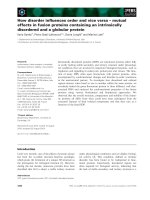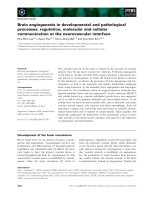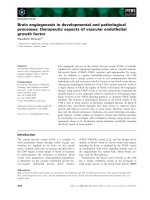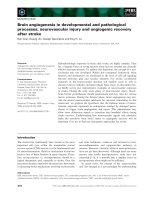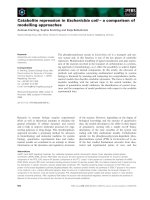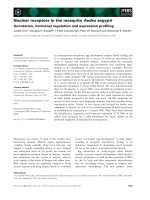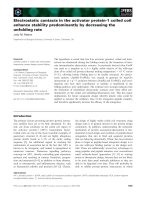Tài liệu Báo cáo khoa học: Brain angiogenesis in developmental and pathological processes: neurovascular injury and angiogenic recovery after stroke docx
Bạn đang xem bản rút gọn của tài liệu. Xem và tải ngay bản đầy đủ của tài liệu tại đây (199.79 KB, 9 trang )
MINIREVIEW
Brain angiogenesis in developmental and pathological
processes: neurovascular injury and angiogenic recovery
after stroke
Ken Arai, Guang Jin, Deepti Navaratna and Eng H. Lo
Neuroprotection Research Laboratory, Massachusetts General Hospital, Harvard Medical School, Charlestown, MA, USA
Introduction
The neuron has traditionally been viewed as the most
important cell type within the mammalian central
nervous system (CNS) because it is the fundamental unit
for neurotransmission. Death or dysfunction in neurons
leads to loss of brain function in many diseases. There-
fore, saving neurons, i.e. neuroprotection, should be a
logical therapeutic goal, especially in stroke. Over the
past many decades, impressive advances have been made
in dissecting stroke mechanisms involving excitotoxicity
and ionic imbalance, oxidative and nitrosative stress,
neuroinflammation and apoptotic-like pathways in
neurons. However, clinically effective neuroprotectants
have not yet been discovered. Although there are many
reasons why stroke neuroprotection trials have not
succeeded [1–3], it is possible that a singular focus on
saving neurons alone might not be sufficient.
In recent years, the concept of the ‘neurovascular
unit’ has emerged as a new paradigm for understanding
Keywords
angiogenesis; edema; endothelial progenitor
cell; hemorrhage; ischemia; matrix
metalloproteinase; neurogenesis;
neurovascular unit; remodeling; stroke
Correspondence
K. Arai, Neuroprotection Research
Laboratory, Massachusetts General
Hospital, Room 2414, 149 13th St,
Charlestown, MA 02129, USA
Fax: +1 617 726 7830
Tel: +1 617 724 9503
E-mail:
(Received 19 February 2009, revised 1 May
2009, accepted 8 May 2009)
doi:10.1111/j.1742-4658.2009.07176.x
Pathophysiologic responses in brain after stroke are highly complex. Thus
far, a singular focus on saving neurons alone has not revealed any clinically
effective neuroprotectants. To address this limitation, the concept of a neu-
rovascular unit was developed. Within this conceptual framework, brain
function and dysfunction are manifested at the level of cell–cell signaling
between neuronal, glial and vascular elements. For stroke, coordinated
responses at the neurovascular interface will mediate acute as well as
chronic events in ischemic and hemorrhagic brain tissue. In this minireview,
we briefly survey two representative examples of neurovascular responses
in stroke. During the early acute phase of neurovascular injury, blood–
brain barrier perturbations should predominate with key roles for various
matrix proteases. During the delayed phase, brain angiogenesis may pro-
vide the critical neurovascular substrates for neuronal remodeling. In this
minireview, we propose the hypothesis that the biphasic nature of neuro-
vascular responses represents an endogenous attempt by damaged paren-
chyma to trigger brain angiogenesis and repair. This phenomenon may
allow acute deleterious signals to transition into beneficial effects during
stroke recovery. Understanding how neurovascular signals and substrates
make the transition from initial injury to angiogenic recovery will be
important if we are to find new therapeutic approaches for stroke.
Abbreviations
BBB, blood–brain barrier; CNS, central nervous system; EPC, endothelial progenitor cell; JNK, c-Jun N-terminal kinase; MMP, matrix
metalloproteinase; NMDA, N-methyl-
D-aspartate; t-PA, tissue-plasminogen activator; VEGF, vascular endothelial growth factor.
4644 FEBS Journal 276 (2009) 4644–4652 Journal compilation ª 2009 FEBS. No claim to original US government works
the pathology of CNS disease, including stroke [3–7]
(Fig. 1). This modular concept is defined at an intercel-
lular level that comprises dynamic interactions between
cerebral endothelial cells, glia, neurons and the extra-
cellular matrix. Dissecting these various signals and
substrates within the neurovascular unit may reveal
opportunities for developing novel therapeutic targets
for CNS disease. Perhaps, preventing neuronal death
per se may not be enough. In order to truly rescue brain
tissue and function, one may have to rescue all the
complex signals and interactions between a network of
multiple cell types, including neurons, astrocytes and
microvascular endothelial cells.
Stroke (also called a brain attack) refers to a hetero-
geneous spectrum of conditions caused by the occlu-
sion or hemorrhage of blood vessels supplying the
brain, and is one of the major causes of death and dis-
ability in developed countries [3]. The initial vascular
event leads to energy loss, which triggers activation of
multiple brain cell death pathways. In addition to
brain injury responses, regenerative responses are also
activated by stroke, such as vascular remodeling,
angiogenesis and neurogenesis. The full spectrum of
pathophysiology after stroke is complex and readers
are referred to many excellent reviews in the field
[4–6,8–10]. In the context of all these multicellular per-
turbations however, it may be useful to ask whether
neurovascular responses after stroke can be reinter-
preted in the context of angiogenesis in the brain. Is it
possible that some of the acute neurovascular events in
the brain after stroke represent an endogenous attempt
by the brain to prepare the substrates necessary for
angiogenesis and recovery? In this minireview, we sur-
vey a few key events in the neurovascular unit, includ-
ing blood–brain barrier (BBB) perturbations, matrix
proteases, coupling between neurogenesis and angio-
genesis, and endothelial progenitor cells (EPCs). We
examine the idea that neurovascular responses underlie
a transition from acute injury to delayed repair as the
brain begins to initiate endogenous angiogenesis that
facilitates neuronal plasticity and remodeling. A sys-
tematic understanding of these responses may eventu-
ally lead us to discover new targets for treating brain
injury after stroke.
Early neurovascular damage in stroke
In the core of the ischemic territory, the initial vascular
event rapidly leads to severe energy loss, and so neuro-
nal death may occur too rapidly for treatment. How-
ever, surrounding the core is an area of mild-to-
moderate vascular compromise called the penumbra.
Within this penumbral area, energy deficits are not as
severe and it is thought that neuronal death occurs via
active cell death mechanisms [11–14]. By understanding
these neuronal death pathways, it is hoped that one
can design methods to block cell death after stroke.
Nevertheless, focusing only on intraneuronal mecha-
nisms may lead us to miss many other critical interac-
tions of neurovascular damage (Fig. 2).
One of the most important facets of early neurovas-
cular damage is manifested as perturbations in BBB
function. Interactions between brain endothelial cells,
astrocytes and adjacent neurons all support BBB func-
tion. After cerebral ischemia, intercellular signaling
within the neurovascular unit becomes disrupted so
that the BBB function is dysfunctional. BBB disrup-
tion leads to vasogenic cerebral edema and hemor-
rhage that eventually exacerbates long-term disability.
To date, numerous deleterious mediators have been
reported to be relevant to early neurovascular damage
(see Green [8] and Lo et al. [3] for more detailed
reviews). Hypoxia may alter the regulation of critical
tight junction proteins [15,16], changes in calcium con-
trol may disrupt the signaling between astrocytes and
endothelial partners [17,18], and activation of inflam-
matory pathways in damaged endothelium might also
open the BBB [19,20].
In recent years, dysregulation of neurovascular pro-
teases has been implicated as central in neurovascular
injury after stroke. In particular, the matrix metallo-
proteinase (MMP) family of extracellular proteases has
been very well studied. MMPs comprise a family of
zinc endopeptidases with major roles in the physiology
and pathology of the mammalian CNS. To date,
MMP-2 (gelatinase A), MMP-3 (stromelysin 1), MMP-
7 (matrilysin), MMP-9 (gelatinase B) and MMP-13
(collagenase-3) are known to contribute to infarct
extent and ⁄ or BBB disruption after stroke [21–25].
There are three main reasons why MMPs are impor-
tant in stroke. First, MMPs can degrade the extracellu-
lar matrix that comprises the basal lamina, thus
damaging the BBB directly. Second, proteolysis of the
0
10
20
30
40
50
200820062004200220001998
Neurovascular unit
Total papers per years
Fig. 1. A search of the PubMed database reveals that research into
many aspects of the ‘neurovascular unit’ has grown significantly
over time. The plot depicts the number of articles published per
year with this phrase listed in the title, abstract or keywords.
K. Arai et al. Neurovascular responses in stroke
FEBS Journal 276 (2009) 4644–4652 Journal compilation ª 2009 FEBS. No claim to original US government works 4645
neurovascular matrix can also trigger anoikis-like
mechanisms of neuronal death [26]. Third, MMPs are
upregulated by tissue-plasminogen activator (t-PA),
which is the only US Food and Drug Administration-
approved thrombolytic treatment for acute ischemic
strokes. The reader is encouraged to seek more
detailed reviews describing the interactions between
MMPs and stroke-induced brain damage [27,28]. Here,
we focus on the relationship between t-PA and MMPs,
insofar as these clinical correlates may be especially
important for stroke therapy in humans.
Thrombolysis with t-PA is logical for acute ischemic
stroke in terms of dissolving clots and reperfusing
brain tissue. However, reperfusion therapy can some-
times be negated by serious complications involving
cerebral edema and hemorrhage. Accumulating evi-
dence suggests that MMP-9 activation is closely related
to those side effects of t-PA. In a hypertensive rat
model of thromboembolic focal cerebral ischemia,
early treatment with t-PA was beneficial, but delayed
t-PA administration worsened outcomes because it
appeared to accelerate MMP-9 activation [29]. Activa-
tion of MMP-9 by t-PA seemed to correlate with hem-
orrhagic conversion and edema. Using a combination
therapy with the broad-spectrum MMP inhibitor BB-
94 plus t-PA showed significantly reduced hemorrhage
volumes compared with those that received t-PA alone,
suggesting that MMPs are involved in the mechanism
of t-PA-associated hemorrhage. This pharmacologic
evidence was subsequently supported by a genetic
study, wherein t-PA knockout mice were used to dem-
onstrate that both endogenous and exogenous t-PA
were related to MMP-9 activation in ischemic brain
[30]. Furthermore, the cellular mechanisms of t-PA-
induced MMP-9 upregulation are now beginning to be
dissected. In endothelial cell cultures, t-PA upregulated
MMP-9 via signaling through the low-density lipopro-
tein receptor-related protein [31]. In vivo, t-PA was
shown to also directly open the BBB in models of
focal ischemia with complex signaling actions involving
the platelet-derived growth factor and low-density lipo-
protein receptors [32,33]. These experimental findings
are now beginning to be supported by clinical data. In
acute stroke patients, t-PA appeared to be correlated
with elevations in plasma levels of MMPs [34], and
these higher MMP levels seem to be somewhat predic-
tive of worsened neurological outcomes [35,36].
Despite the promising data, much more work needs
to be done. Many experimental and clinical studies
have focused on MMP-2 and MMP-9 because they
interact with t-PA and there are simple and reproduc-
ible assays to detect their levels via gelatin zymography
or ELISAs. Of course, other MMPs may also be
involved because these proteases are known to func-
tion as a network. Using knockout mice, a recent
study demonstrated that MMP-3 is important media-
tor for t-PA-induced intracranial bleeding in mouse
models of focal stroke [37]. In this model, co-treatment
with the broad-spectrum MMP inhibitor GM6001
effectively reduced intracranial bleeding. More
recently, it was reported that minocycline might be a
potential agent to downregulate t-PA-induced MMP-9
activation and ameliorate t-PA-associated hemorrhage
during reperfusion therapy in stroke [38]. The transla-
tional attractiveness of this approach lies in the fact
that minocycline can be easily used in humans.
Taken together, the accumulating experimental and
clinical data suggest that MMPs (and perhaps other
extracellular proteases) may mediate neurovascular
injury during the acute stages of stroke. In this regard,
< Acute stroke phase >
Stroke
< Normal conditions >
Endothelium
Endothelium
Neuron
Neuron
BB
B
n
o
ita
l
uge
r
Neurotransmitter
dynamics
GLIAGLIA
BBB
n
oi
t
p
u
r
s
id
Glutamate accumulation
ionic imbalance
Loss of support
from endothelium
Functional
dynamics
Matrix interactions for
cell survival signals
Cell death
Fig. 2. A schematic summary of the interactions between various elements within the neurovascular unit under normal and diseased condi-
tions after stroke. The concept of the neurovascular unit emphasizes the importance of cell–cell signaling between neurons, astrocytes and
endothelium. When homeostatic cell–cell interactions are degraded by various insults, normal brain functions no longer operate. These
concepts might apply both to stroke and perhaps more broadly to other CNS diseases as well.
Neurovascular responses in stroke K. Arai et al.
4646 FEBS Journal 276 (2009) 4644–4652 Journal compilation ª 2009 FEBS. No claim to original US government works
targeting these neurovascular proteases may serve as a
powerful combination therapy with t-PA thrombolysis
[39]. However, an important caveat here is that con-
served responses in this regard may also play differen-
tial roles during later stages of stroke evolution. Is it
possible that acute mechanisms of neurovascular injury
are altered to beneficial neurovascular remodeling over
the course of stroke recovery? Here, we propose the
hypothesis that these acute neurovascular events may,
in fact, represent an endogenous attempt by the brain
to initiate angiogenic recovery. Altered calcium signal-
ing between astrocytes and the corresponding endothe-
lial cells may underlie proximal triggers for vascular
remodeling. Loosening of tight junctions occurs as
endothelial cells disengage in preparation to move; and
of course, upregulation of extracellular proteases such
as MMPs is required for angiogenesis and vasculogen-
esis. Attempts to retard any of these acute neurovascu-
lar events will have to be carefully titrated so that
delayed neuronal, glial and endothelial recovery is not
impaired.
Angiogenesis, neurovascular repair and
stroke recovery
During the acute phase of stroke, the ischemic penum-
bra suffers milder insults because of residual perfusion
from collateral blood vessels compared with the core
of the ischemic territory. Over the course of hours to
days, the penumbra collapses if therapy is not initiated
in time. Besides neuronal death per se, collapse of the
acute penumbra can also be viewed in terms of the
degradation of cell–cell interactions in the neurovascu-
lar unit (Fig. 2). Loss of signaling between astrocytes
and endothelium alters tight junction homeostasis and
leads to BBB disruption. Perturbations in neuronal–
glial signaling lead to loss of proper neurotransmitter
dynamics. And loss of matrix–trophic interactions
between the vascular and neuronal elements may trig-
ger parenchymal injury beyond ischemia itself. In the
face of this acute neurovascular injury, it is beginning
to be recognized that evolution of the penumbra may
also mediate recovery. The penumbra is not just dying
over time. It can also be actively trying to repair itself
because endogenous mechanisms of plasticity and
remodeling occur over days to weeks after stroke onset
[12].
The primary neurovascular responses during stroke
recovery are thought to involve angiogenesis and
neurogenesis. Angiogenesis is the key step for recovery
after ischemia in other organs. So it is reasonable to
expect that similar processes would occur in the
brain after stroke. In penumbral regions, increased
microvessel density has been observed in human
patients [40]. In at least one study, the number of new
vessels appeared to be related to longer survival times
in ischemic stroke patients, suggesting that active
angiogenesis may be beneficial [41]. In contrast, older
patients who tend to do worse after stroke [42,43]
seem to have reduced new vessel formation after stroke
[44]. Furthermore, patients who develop dementia after
stroke may suffer from reduced blood flow in adjacent
cortical regions [45]. This raises the possibility that
angiogenesis may improve cerebral perfusion and func-
tion as part of a network repair.
The spatial and temporal dynamics of post-stroke
angiogenesis are complex and remain incompletely
characterized. Nevertheless, it has been generally docu-
mented that the proliferation of brain endothelial cells
is indeed triggered after ischemic events [44,46]. In
mice, endothelial proliferation may begin within a day
after ischemia and persist for up to several weeks
thereafter [47,48]. Genes correlated with brain angio-
genesis have also been extensively assessed in experi-
mental stroke models. For example, endogenous
signals for vascular endothelial growth factor (VEGF)
appear in both neurons and astrocytes after focal cere-
bral ischemia [49,50]. Boosting VEGF also seems to
promote recovery. Infusing VEGF into the lateral ven-
tricles stimulated angiogenesis and decreased infarct
volume in rodent models of focal cerebral ischemia
[51]. An increase in angiogenesis by VEGF in rats was
associated with reduced neurological deficits after focal
cerebral ischemia [50]. In addition to these biochemical
and pharmacologic findings, genetic data have also
been obtained. In transgenic mice overexpressing
human VEGF165, brain microvessel density was signif-
icantly elevated compared with wild-type mice before
ischemia, and the increase in microvessel density
3 days after stroke onset was improved [52]. These
data show that VEGF promotes revascularization after
stroke.
Increasing evidence in both human stroke patients
and animal stroke models suggests that angiogenesis
can occur in the penumbral areas that seek to recover.
However, it remains to be fully elucidated whether
these new vessels are truly functional. It is worth not-
ing that Lyden and colleagues have proposed a ‘clean-
up hypothesis’, whereby newborn vessels serve to facil-
itate macrophage infiltration, and clear up and remove
cellular debris from pan-necrotic tissue [53,54]. This
alternate hypothesis would suggest that post-stroke
brain angiogenesis is only transient and not perma-
nently involved in neuronal recovery. Nevertheless, the
data in aggregate support a beneficial role for angio-
genesis and neurovascular repair, together with a close
K. Arai et al. Neurovascular responses in stroke
FEBS Journal 276 (2009) 4644–4652 Journal compilation ª 2009 FEBS. No claim to original US government works 4647
coupling between angiogenesis and neurogenesis. The
reader is referred to more detailed reviews that
describe these neurovascular remodeling phenomena
[9,55,56]. Here, we now focus on the concept that neu-
rovascular recovery in fact, utilizes the same mediators
that appear to underlie acute injury.
As discussed above, a major mediator in typically
involved in neurovascular responses is VEGF. In this
regard, VEGF is the prototypical biphasic mediator.
Like MMPs, VEGF increases BBB permeability in the
acute phase in stroke. VEGF administration worsens
BBB leakage by ischemic insults. By contrast, VEGF
can accelerate angiogenesis and neurogenesis responses
in the delayed stroke phase. VEGF can trigger remod-
eling responses in both endothelial cells and neurons
(see Fagan et al. [57] and Hansen et al. [58] for full
and detailed reviews for those opposite actions of
VEGF). Furthermore, there may also be feedback
loops because MMPs can process pro-forms of matrix-
bound VEGF into freely diffusible bioactive forms of
VEGF [59]. Altogether, the interactions between
MMPs and pro-angiogenic mediators such as VEGF
should provide a complex but rich substrate for post-
stroke angiogenesis.
Neurovascular proteases such as MMPs damage the
BBB and cause edema, hemorrhage and neuronal
death in the acute stroke phase. However, recent stud-
ies suggest that these same proteases may have a bene-
ficial role during neurovascular repair. In a mouse
stroke model, peri-infarct cortical areas demonstrate a
secondary elevation in MMP-9 in endothelial and glial
cells within networks of regrowing microvessels [60];
and inhibition of MMPs during this delayed phase
actually made outcomes worse with the development
of hemorrhagic and malformed blood vessels and
enlarged volumes of infarction and cavitation. Beyond
the peri-infarct zone, other brains areas were also
involved. Secondary MMP-9 signals co-localized with
streams of migrating neuroblasts from the subventri-
cular zone, and inhibition of these MMPs also blocked
the movement of these neuroblasts, originally headed
towards damaged brain [61].
Beyond VEGF and MMPs, the concept of biphasic
neurovascular responses may apply more broadly to a
large spectrum of other mediators. The N-methyl-d-
aspartate (NMDA) receptor is one of the most inten-
sely studied targets in neuroprotection in acute stroke,
because glutamate-induced excitotoxicity has been
thought of as the main reason for neuronal cell death.
Although NMDA receptor activation in the acute
phase leads to neuronal damage, the same NMDA sig-
naling may participate in neurovascular repair (espe-
cially neurogenesis) in the recovery phase [62]. In
addition to ‘extracellular’ mediators (MMP, VEGF,
glutamate activation of NMDA receptors), intracellu-
lar signals may also demonstrate biphasic profiles. The
stress-activated protein kinase c-Jun N-terminal kinase
(JNK) pathway is known to trigger many cell death
pathways including caspases, and many studies have
shown that JNK inhibitors are neuroprotective in
rodent stroke models (see Kuan and Burke [63] for a
full and detailed review). However, more recent data
clearly support a beneficial role for JNK in CNS dis-
ease and repair [64]. JNK signaling is involved in neu-
ronal precursor cell migration, microtubule assembly
and axonal guidance during brain development. After
injury, this signal can contribute to dendritic sprouting
and axonal regrowth. More recently, JNK has also
been shown to mediate angiogenesis [65]. JNK medi-
ates the regulation of both VEGF and MMPs, and
blockade of JNK cascades with inhibitors can suppress
angiogenesis in tumor cell systems [66,67]. Whether
similar pathways are activated in cerebral neurovascu-
lar repair and remodeling remains to be determined,
but given the emphasis on targeting JNK in acute
stroke, these types of biphasic repair responses deserve
consideration. An untitrated wholesale inhibition of
JNK may worsen stroke recovery by preventing neuro-
vascular remodeling.
Interactions between angiogenesis and neuronal
restoration can also be manifested in terms of circulat-
ing EPCs. EPCs are immature endothelial cells which
circulate in peripheral blood [68] and are under matura-
tion process to become endothelial cells. Hence, EPCs
possess functional and structural characteristics of both
stem cells and mature endothelial cells. As discussed
above, angiogenesis in the penumbra area is an impor-
tant natural response to stroke. Although circulating
EPCs represent only 0.01% of cells in the blood
under steady-state conditions, EPC numbers are highly
affected by stroke onset. Emerging studies are begin-
ning to elucidate the relationship between stroke out-
come and the number of circulating EPCs. In rodent
models of focal cerebral ischemia, there was a strong
correlation between the volume and severity of infarcts
and the absolute number of circulating CD34+ and
CD133+ cells (both thought to be markers for EPCs)
[69]. In clinical stroke patients, an increase in circulat-
ing EPCs after acute ischemic stroke was associated
with good functional outcome and reduced infarct
growth and maturation [70]. Importantly, from flow
cytometry measurements, EPC levels were significantly
lower in patients with severe neurological impairment
compared with patients with less severe impairments at
48 h after ischemic stroke [71]. In mouse cerebral ische-
mia models, bone marrow-derived EPCs homed to the
Neurovascular responses in stroke K. Arai et al.
4648 FEBS Journal 276 (2009) 4644–4652 Journal compilation ª 2009 FEBS. No claim to original US government works
ischemic core and participated in cerebral neovascular-
ization [72]. These observations raise the possibility
that EPCs can be used as a therapeutic approach for
promoting repair (see Rouhl et al. [73] for a full and
detailed review). Perhaps, there are even ways to aug-
ment EPC function. Recent experiments suggest that
high-mobility group box 1 (HMGB1) and interleuk in-
1beta can promote EPC homing and proliferation,
respectively [74,75]; simply increasing motor activity
with exercise also seemed to amplify EPC numbers and
improve outcomes after focal cerebral ischemia in mice
[76]. All these ideas hold promise that combination
approaches may be explored to leverage the power of
EPCs for angiogenic recovery. However, the precise
mechanisms of the EPC contribution to postnatal
angiogenesis remain to be elucidated. It has been
reported that bone marrow-derived EPCs did not
incorporate into the adult growing vasculature [77].
Furthermore, mobilized bone marrow-derived EPCs
have been shown to enhance the angiogenic response to
hypoxia without differentiation into endothelial cells
[78]. These reports suggest that EPCs support angio-
genesis indirectly through growth factor release. There-
fore, the idea of EPC usage as a clinical application
will have to be carefully developed and assessed before
EPCs can be safely tested and applied in clinical stroke.
Taken together, accumulating data now suggest that
neurovascular mediators span a very wide range of
responses after stroke. Some are detrimental, whereas
some are beneficial. Perhaps, acute neurovascular
responses serve to prepare the substrates required for
later angiogenesis and brain recovery (Fig. 3). Because
similar signals and substrates are involved, one will
have to be very careful in terms of understanding how
and when these injury-into-repair transitions take
place. Otherwise, acute neurovascular inhibition strate-
gies may interfere with angiogenesis and worsen stroke
recovery instead.
Conclusions
The brain is a highly complex organ. Seeking efficient
targets to treat brain diseases may be extremely diffi-
cult. For stroke, we have seen numerous clinical trials
fail. Although there are many reasons why these trials
have not worked, the concept of a neurovascular unit
has emerged in recent years, to suggest that a broader
analysis beyond only neurons is required. Interactions
between neuronal, glial and vascular elements in brain
mediate function. Loss of proper signaling in the neu-
rovascular unit underlies disease. In this minireview,
we briefly overviewed the current knowledge regarding
neurovascular injury and repair in stroke. We propose
the hypothesis that acute neurovascular events may
sometimes represent early triggers for endogenous
attempts at delayed angiogenesis later on. Cell–cell sig-
naling in the neurovascular unit is altered, tight junc-
tions are disengaged, extracellular proteases are
activated and circulating endothelial precursors may be
recruited. Understanding how these acute events tran-
sition into delayed neurovascular remodeling is critical.
Finding ways to regulate neurovascular perturbations
and promote brain angiogenesis may allow us to
develop new therapeutic opportunities for stroke.
Acknowledgements
Supported in part by P01-NS55104, P50-NS10828,
R01-NS37074, R01-NS48422, R01-NS53560, the
American Heart Association and the Deane Institute.
References
1 Gladstone DJ, Black SE & Hakim AM (2002) Toward
wisdom from failure: lessons from neuroprotective
stroke trials and new therapeutic directions. Stroke 33,
2123–2136.
2 Wahlgren NG & Ahmed N (2004) Neuroprotection in
cerebral ischaemia: facts and fancies – the need for new
approaches. Cerebrovasc Dis 17(Suppl 1), 153–166.
3 Lo EH, Dalkara T & Moskowitz MA (2003) Mecha-
nisms, challenges and opportunities in stroke. Nat Rev
Neurosci 4, 399–415.
Neurovascular injury
Neurovascular recovery
e
h ,amede ,noitpursid BB
B()htaed
lanorue
n ,egahrr
om
lb
o
r
ue
n
,si
sene
g
o
r
uen ,
s
is
e
nego
igna
( )
g
nile
d
omerciti
rd
n
ed ,n
oi
targimtsa
.
c
t
e
KNJ ,ADMN ,FGEV ,sPM
M
Acute phase
Delayed phase
Fig. 3. A schematic depiction of the dual-edged nature of MMPs,
VEGF, NMDA and JNK after stroke. In the acute phase, those
mediators mediate neurovascular injury by disrupting the BBB
and ⁄ or brain cell death. In the delayed phase, they may support
neurovascular remodeling by enhancing neurogenesis and ⁄ or angio-
genesis. The transition between negative and positive effects in
clinical stroke remains to be determined.
K. Arai et al. Neurovascular responses in stroke
FEBS Journal 276 (2009) 4644–4652 Journal compilation ª 2009 FEBS. No claim to original US government works 4649
4 del Zoppo GJ (2006) Stroke and neurovascular protec-
tion. N Engl J Med 354, 553–555.
5 Iadecola C (2004) Neurovascular regulation in the nor-
mal brain and in Alzheimer’s disease. Nat Rev Neurosci
5, 347–360.
6 Zlokovic BV (2008) The blood–brain barrier in health
and chronic neurodegenerative disorders. Neuron 57,
178–201.
7 Lok J, Gupta P, Guo S, Kim WJ, Whalen MJ, van
Leyen K & Lo EH (2007) Cell-cell signaling in the
neurovascular unit. Neurochem Res 32, 2032–2045.
8 Green AR (2008) Pharmacological approaches to acute
ischaemic stroke: reperfusion certainly, neuroprotection
possibly. Br J Pharmacol 153(Suppl 1), S325–S338.
9 Chopp M, Zhang ZG & Jiang Q (2007) Neurogenesis,
angiogenesis, and MRI indices of functional recovery
from stroke. Stroke 38, 827–831.
10 Greenberg DA & Jin K (2006) Growth factors and
stroke. NeuroRx 3, 458–465.
11 Castellanos M, Sobrino T & Castillo J (2006) Evolving
paradigms for neuroprotection: molecular identification
of ischemic penumbra. Cerebrovasc Dis 21(Suppl 2),
71–79.
12 Lo EH (2008) A new penumbra: transitioning from
injury into repair after stroke. Nat Med 14, 497–500.
13 Ginsberg MD (2003) Adventures in the pathophysiol-
ogy of brain ischemia: penumbra, gene expression,
neuroprotection: the 2002 Thomas Willis Lecture.
Stroke 34, 214–223.
14 Zheng Z, Zhao H, Steinberg GK & Yenari MA (2003)
Cellular and molecular events underlying ischemia-
induced neuronal apoptosis. Drug News Perspect 16,
497–503.
15 Yamagata K, Tagami M, Takenaga F, Yamori Y &
Itoh S (2004) Hypoxia-induced changes in tight junction
permeability of brain capillary endothelial cells are asso-
ciated with IL-1beta and nitric oxide. Neurobiol Dis 17,
491–499.
16 Mark KS & Davis TP (2002) Cerebral microvascular
changes in permeability and tight junctions induced by
hypoxia-reoxygenation. Am J Physiol Heart Circ Phys-
iol 282, H1485–H1494.
17 Wang X, Takano T & Nedergaard M (2009) Astro-
cytic calcium signaling: mechanism and implications
for functional brain imaging. Methods Mol Biol 489,
93–109.
18 Iadecola C & Nedergaard M (2007) Glial regulation of
the cerebral microvasculature. Nat Neurosci 10, 1369–
1376.
19 Huang J, Upadhyay UM & Tamargo RJ (2006) Inflam-
mation in stroke and focal cerebral ischemia. Surg Neu-
rol 66, 232–245.
20 Fisher M (2008) Injuries to the vascular endothelium:
vascular wall and endothelial dysfunction. Rev Neurol
Dis 5(Suppl 1), S4–S11.
21 Anthony DC, Ferguson B, Matyzak MK, Miller KM,
Esiri MM & Perry VH (1997) Differential matrix
metalloproteinase expression in cases of multiple
sclerosis and stroke. Neuropathol Appl Neurobiol 23,
406–415.
22 Montaner J, Alvarez-Sabin J, Molina C, Angles A,
Abilleira S, Arenillas J, Gonzalez MA & Monasterio J
(2001) Matrix metalloproteinase expression after human
cardioembolic stroke: temporal profile and relation to
neurological impairment. Stroke 32, 1759–1766.
23 Rosell A, Alvarez-Sabin J, Arenillas JF, Rovira A, Del-
gado P, Fernandez-Cadenas I, Penalba A, Molina CA
& Montaner J (2005) A matrix metalloproteinase pro-
tein array reveals a strong relation between MMP-9 and
MMP-13 with diffusion-weighted image lesion increase
in human stroke. Stroke 36, 1415–1420.
24 Alvarez-Sabin J, Delgado P, Abilleira S, Molina CA,
Arenillas J, Ribo M, Santamarina E, Quintana M,
Monasterio J & Montaner J (2004) Temporal profile of
matrix metalloproteinases and their inhibitors after
spontaneous intracerebral hemorrhage: relationship to
clinical and radiological outcome. Stroke 35, 1316–
1322.
25 Horstmann S, Kalb P, Koziol J, Gardner H & Wagner
S (2003) Profiles of matrix metalloproteinases, their
inhibitors, and laminin in stroke patients: influence of
different therapies. Stroke 34, 2165–2170.
26 Gu Z, Kaul M, Yan B, Kridel SJ, Cui J, Strongin A,
Smith JW, Liddington RC & Lipton SA (2002) S-Nitro-
sylation of matrix metalloproteinases: signaling pathway
to neuronal cell death. Science 297, 1186–1190.
27 Cunningham LA, Wetzel M & Rosenberg GA (2005)
Multiple roles for MMPs and TIMPs in cerebral ische-
mia. Glia 50, 329–339.
28 Rosell A & Lo EH (2008) Multiphasic roles for matrix
metalloproteinases after stroke. Curr Opin Pharmacol 8,
82–89.
29 Sumii T & Lo EH (2002) Involvement of matrix metal-
loproteinase in thrombolysis-associated hemorrhagic
transformation after embolic focal ischemia in rats.
Stroke 33, 831–836.
30 Tsuji K, Aoki T, Tejima E, Arai K, Lee SR, Atochin
DN, Huang PL, Wang X, Montaner J & Lo EH (2005)
Tissue plasminogen activator promotes matrix metallo-
proteinase-9 upregulation after focal cerebral ischemia.
Stroke 36, 1954–1959.
31 Wang X, Lee SR, Arai K, Tsuji K, Rebeck GW &
Lo EH (2003) Lipoprotein receptor-mediated induction
of matrix metalloproteinase by tissue plasminogen
activator. Nat Med 9, 1313–1317.
32 Yepes M, Sandkvist M, Moore EG, Bugge TH, Strick-
land DK & Lawrence DA (2003) Tissue-type plasmino-
gen activator induces opening of the blood-brain barrier
via the LDL receptor-related protein. J Clin Invest 112,
1533–1540.
Neurovascular responses in stroke K. Arai et al.
4650 FEBS Journal 276 (2009) 4644–4652 Journal compilation ª 2009 FEBS. No claim to original US government works
33 Su EJ, Fredriksson L, Geyer M, Folestad E, Cale J,
Andrae J, Gao Y, Pietras K, Mann K, Yepes M et al.
(2008) Activation of PDGF-CC by tissue plasminogen
activator impairs blood-brain barrier integrity during
ischemic stroke. Nat Med 14, 731–737.
34 Ning M, Furie KL, Koroshetz WJ, Lee H, Barron M,
Lederer M, Wang X, Zhu M, Sorensen AG, Lo EH
et al. (2006) Association between tPA therapy and
raised early matrix metalloproteinase-9 in acute stroke.
Neurology 66, 1550–1555.
35 Castellanos M, Sobrino T, Millan M, Garcia M,
Arenillas J, Nombela F, Brea D, Perez de la Ossa N,
Serena J, Vivancos J et al. (2007) Serum cellular
fibronectin and matrix metalloproteinase-9 as screening
biomarkers for the prediction of parenchymal
hematoma after thrombolytic therapy in acute ischemic
stroke: a multicenter confirmatory study. Stroke 38,
1855–1859.
36 Montaner J (2006) Stroke biomarkers: can they help us
to guide stroke thrombolysis? Drug News Perspect 19,
523–532.
37 Suzuki Y, Nagai N, Umemura K, Collen D & Lijnen
HR (2007) Stromelysin-1 (MMP-3) is critical for intra-
cranial bleeding after t-PA treatment of stroke in mice.
J Thromb Haemost 5, 1732–1739.
38 Murata Y, Rosell A, Scannevin RH, Rhodes KJ, Wang
X & Lo EH (2008) Extension of the thrombolytic time
window with minocycline in experimental stroke. Stroke
39, 3372–3377.
39 Lapchak PA & Araujo DM (2001) Reducing bleeding
complications after thrombolytic therapy for stroke:
clinical potential of metalloproteinase inhibitors and
spin trap agents. CNS Drugs 15, 819–829.
40 Krupinski J, Kaluza J, Kumar P, Kumar S &
Wang JM (1993) Some remarks on the growth-rate
and angiogenesis of microvessels in ischemic stroke.
Morphometric and immunocytochemical studies. Patol
Pol 44, 203–209.
41 Krupinski J, Kaluza J, Kumar P, Kumar S & Wang
JM (1994) Role of angiogenesis in patients with cerebral
ischemic stroke. Stroke 25, 1794–1798.
42 Allen CM (1984) Predicting the outcome of acute
stroke: a prognostic score. J Neurol Neurosurg Psychia-
try 47, 475–480.
43 Granger CV, Hamilton BB & Fiedler RC (1992)
Discharge outcome after stroke rehabilitation. Stroke
23, 978–982.
44 Szpak GM, Lechowicz W, Lewandowska E, Bertrand
E, Wierzba-Bobrowicz T & Dymecki J (1999) Border
zone neovascularization in cerebral ischemic infarct.
Folia Neuropathol 37, 264–268.
45 Schmidt R, Schmidt H & Fazekas F (2000) Vascular
risk factors in dementia. J Neurol 247, 81–87.
46 Chen HH, Chien CH & Liu HM (1994) Correlation
between angiogenesis and basic fibroblast growth factor
expression in experimental brain infarct. Stroke 25,
1651–1657.
47 Hayashi T, Noshita N, Sugawara T & Chan PH (2003)
Temporal profile of angiogenesis and expression of
related genes in the brain after ischemia. J Cereb Blood
Flow Metab 23, 166–180.
48 Marti HJ, Bernaudin M, Bellail A, Schoch H, Euler M,
Petit E & Risau W (2000) Hypoxia-induced vascular
endothelial growth factor expression precedes neovascu-
larization after cerebral ischemia. Am J Pathol 156,
965–976.
49 Abe K, Setoguchi Y, Hayashi T & Itoyama Y (1997)
Dissociative expression of adenoviral-mediated E. coli
LacZ gene between ischemic and reperfused rat brains.
Neurosci Lett
226, 53–56.
50 Zhang ZG, Zhang L, Jiang Q, Zhang R, Davies K,
Powers C, Bruggen N & Chopp M (2000) VEGF
enhances angiogenesis and promotes blood–brain
barrier leakage in the ischemic brain. J Clin Invest 106,
829–838.
51 Sun Y, Jin K, Xie L, Childs J, Mao XO, Logvinova A
& Greenberg DA (2003) VEGF-induced neuroprotec-
tion, neurogenesis, and angiogenesis after focal cerebral
ischemia. J Clin Invest 111, 1843–1851.
52 Wang Y, Kilic E, Kilic U, Weber B, Bassetti CL, Marti
HH & Hermann DM (2005) VEGF overexpression
induces post-ischaemic neuroprotection, but facilitates
haemodynamic steal phenomena. Brain 128, 52–63.
53 Manoonkitiwongsa PS, Jackson-Friedman C, McMillan
PJ, Schultz RL & Lyden PD (2001) Angiogenesis after
stroke is correlated with increased numbers of macro-
phages: the clean-up hypothesis. J Cereb Blood Flow
Metab 21, 1223–1231.
54 Yu SW, Friedman B, Cheng Q & Lyden PD (2007)
Stroke-evoked angiogenesis results in a transient popu-
lation of microvessels. J Cereb Blood Flow Metab 27,
755–763.
55 Slevin M, Kumar P, Gaffney J, Kumar S & Krupinski
J (2006) Can angiogenesis be exploited to improve
stroke outcome? Mechanisms and therapeutic potential
Clin Sci (Lond) 111, 171–183.
56 Zhang RL, Zhang ZG & Chopp M (2008) Ischemic
stroke and neurogenesis in the subventricular zone.
Neuropharmacology 55, 345–352.
57 Fagan SC, Hess DC, Hohnadel EJ, Pollock DM &
Ergul A (2004) Targets for vascular protection after
acute ischemic stroke. Stroke 35, 2220–2225.
58 Hansen TM, Moss AJ & Brindle NP (2008) Vascular
endothelial growth factor and angiopoietins in neuro-
vascular regeneration and protection following stroke.
Curr Neurovasc Res 5, 235–244.
59 Lee S, Jilani SM, Nikolova GV, Carpizo D & Iruela-
Arispe ML (2005) Processing of VEGF-A by matrix
metalloproteinases regulates bioavailability and vascular
patterning in tumors. J Cell Biol 169, 681–691.
K. Arai et al. Neurovascular responses in stroke
FEBS Journal 276 (2009) 4644–4652 Journal compilation ª 2009 FEBS. No claim to original US government works 4651
60 Zhao BQ, Wang S, Kim HY, Storrie H, Rosen BR,
Mooney DJ, Wang X & Lo EH (2006) Role of matrix
metalloproteinases in delayed cortical responses after
stroke. Nat Med 12, 441–445.
61 Lee SR, Kim HY, Rogowska J, Zhao BQ, Bhide P,
Parent JM & Lo EH (2006) Involvement of matrix
metalloproteinase in neuroblast cell migration from the
subventricular zone after stroke. J Neurosci 26, 3491–
3495.
62 Arvidsson A, Kokaia Z & Lindvall O (2001) N-methyl-
d-aspartate receptor-mediated increase of neurogenesis
in adult rat dentate gyrus following stroke. Eur J Neu-
rosci 14, 10–18.
63 Kuan CY & Burke RE (2005) Targeting the JNK signal-
ing pathway for stroke and Parkinson’s diseases therapy.
Curr Drug Targets CNS Neurol Disord 4, 63–67.
64 Waetzig V, Zhao Y & Herdegen T (2006) The bright
side of JNKs - multitalented mediators in neuronal
sprouting, brain development and nerve fiber regenera-
tion. Prog Neurobiol 80, 84–97.
65 Uchida C, Gee E, Ispanovic E & Haas TL (2008) JNK
as a positive regulator of angiogenic potential in endo-
thelial cells. Cell Biol Int 32, 769–776.
66 Miura S, Matsuo Y & Saku K (2008) Jun N-terminal
kinase inhibitor blocks angiogenesis by blocking VEGF
secretion and an MMP pathway. J Atheroscler Thromb
15, 69–74.
67 Yoshino Y, Aoyagi M, Tamaki M, Duan L, Morimoto T
& Ohno K (2006) Activation of p38 MAPK and ⁄ or JNK
contributes to increased levels of VEGF secretion in
human malignant glioma cells. Int J Oncol 29, 981–987.
68 Asahara T, Murohara T, Sullivan A, Silver M, van der
Zee R, Li T, Witzenbichler B, Schatteman G & Isner
JM (1997) Isolation of putative progenitor endothelial
cells for angiogenesis. Science 275, 964–967.
69 Taguchi A, Matsuyama T, Moriwaki H, Hayashi T,
Hayashida K, Nagatsuka K, Todo K, Mori K, Stern
DM, Soma T et al. (2004) Circulating CD34-positive
cells provide an index of cerebrovascular function.
Circulation 109, 2972–2975.
70 Sobrino T, Hurtado O, Moro MA, Rodriguez-Yanez
M, Castellanos M, Brea D, Moldes O, Blanco M,
Arenillas JF, Leira R et al. (2007) The increase of circu-
lating endothelial progenitor cells after acute ischemic
stroke is associated with good outcome. Stroke 38,
2759–2764.
71 Yip HK, Chang LT, Chang WN, Lu CH, Liou CW,
Lan MY, Liu JS, Youssef AA & Chang HW (2008)
Level and value of circulating endothelial progenitor
cells in patients after acute ischemic stroke. Stroke 39,
69–74.
72 Zhang ZG, Zhang L, Jiang Q & Chopp M (2002) Bone
marrow-derived endothelial progenitor cells participate
in cerebral neovascularization after focal cerebral ische-
mia in the adult mouse. Circ Res 90, 284–288.
73 Rouhl RP, van Oostenbrugge RJ, Damoiseaux J, Cohen
Tervaert JW & Lodder J (2008) Endothelial progenitor
cell research in stroke: a potential shift in pathophysio-
logical and therapeutical concepts. Stroke 39, 2158–
2165.
74 Chavakis E, Hain A, Vinci M, Carmona G, Bianchi
ME, Vajkoczy P, Zeiher AM, Chavakis T & Dimmeler
S (2007) High-mobility group box 1 activates integrin-
dependent homing of endothelial progenitor cells. Circ
Res 100, 204–212.
75 Rosell A, Arai K, Lok J, He T, Guo S, Navarro M,
Montaner J, Katusic ZS & Lo EH (2009) Interleukin-
1beta augments angiogenic responses of murine endo-
thelial progenitor cells in vitro.
J Cereb Blood Flow
Metab 29, 933–943.
76 Laufs U, Werner N, Link A, Endres M, Wassmann S,
Jurgens K, Miche E, Bohm M & Nickenig G (2004)
Physical training increases endothelial progenitor cells,
inhibits neointima formation, and enhances angiogene-
sis. Circulation 109, 220–226.
77 Ziegelhoeffer T, Fernandez B, Kostin S, Heil M,
Voswinckel R, Helisch A & Schaper W (2004) Bone
marrow-derived cells do not incorporate into the adult
growing vasculature. Circ Res 94, 230–238.
78 O’Neill TJ IV, Wamhoff BR, Owens GK & Skalak TC
(2005) Mobilization of bone marrow-derived cells
enhances the angiogenic response to hypoxia without
transdifferentiation into endothelial cells. Circ Res 97,
1027–1035.
Neurovascular responses in stroke K. Arai et al.
4652 FEBS Journal 276 (2009) 4644–4652 Journal compilation ª 2009 FEBS. No claim to original US government works



